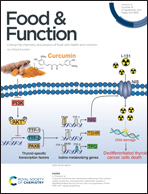Grape seed proanthocyanidins reduced the overweight of C57BL/6J mice through modulating adipose thermogenesis and gut microbiota
Abstract
Activating the thermogenic function of adipocytes is an attractive therapeutic strategy against obesity and its associated metabolic complications. Proanthocyanidins are a class of polyphenols which are widely found in plants and daily foods. This aim of this study is to investigate the modulatory effects of grape seed proanthocyanidin extract (GSPE) on brown adipose tissue (BAT) activity, browning of white adipose tissue (WAT) and microbiome regulation in high-fat diet (HFD)-fed mice and its associated molecular mechanism. An 8-week administration of GSPE at 200 mg per kg bw in mice significantly reduced their final body weight, antagonized their HFD-induced insulin resistance and elevated their levels of adiponectin and leptin, respectively (p < 0.05). GSPE significantly increased the expression levels of thermogenic marker UCP1 in BAT and elevated the expression of a key transcription factor of browning, PRDM16, and thermogenic markers UCP1 and PGC-1α in inguinal white adipose tissue (iWAT). The high doses of GSPE also increased the levels of acetic acid, propionic acid and butyric acid in the colon of HFD-fed mice (p < 0.05). Furthermore, GSPE normalized the colonic Firmicutes/Bacteroidetes ratios, reversed the relative abundance of Weissella, Faecalibaculum, Bacteroides, Akkermansia and Ruminococcus 1 induced by HFD, and improved the structural diversity of the gut microbiota in C57BL/6J mice.



 Please wait while we load your content...
Please wait while we load your content...